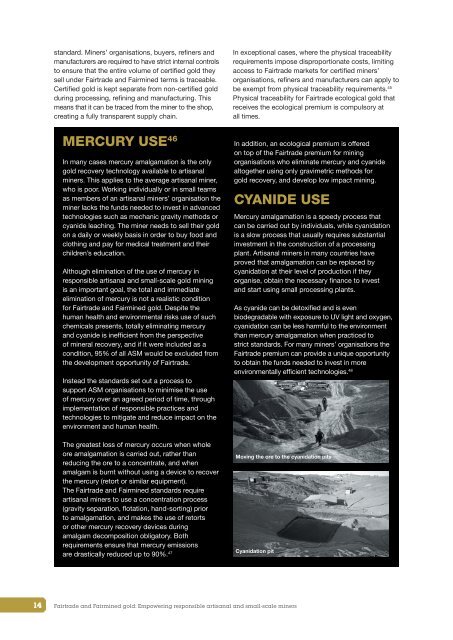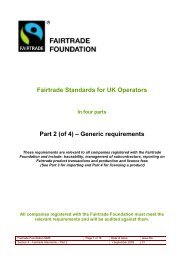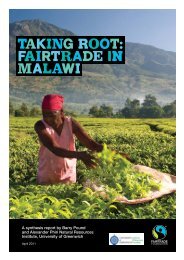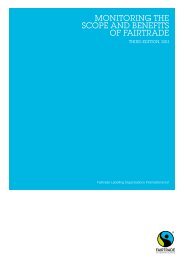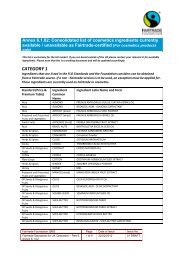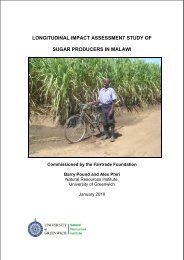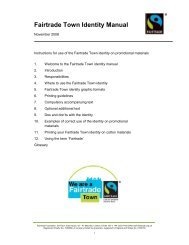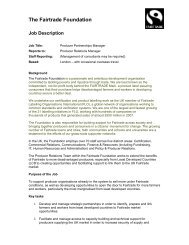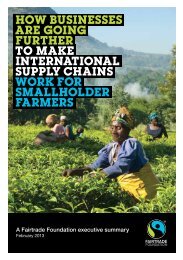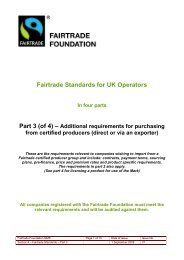FAIRTRADE AND FAIRMINED GOLD - The Fairtrade Foundation
FAIRTRADE AND FAIRMINED GOLD - The Fairtrade Foundation
FAIRTRADE AND FAIRMINED GOLD - The Fairtrade Foundation
Create successful ePaper yourself
Turn your PDF publications into a flip-book with our unique Google optimized e-Paper software.
standard. Miners’ organisations, buyers, refiners and<br />
manufacturers are required to have strict internal controls<br />
to ensure that the entire volume of certified gold they<br />
sell under <strong>Fairtrade</strong> and Fairmined terms is traceable.<br />
Certified gold is kept separate from non-certified gold<br />
during processing, refining and manufacturing. This<br />
means that it can be traced from the miner to the shop,<br />
creating a fully transparent supply chain.<br />
MERCURY USE 46<br />
In many cases mercury amalgamation is the only<br />
gold recovery technology available to artisanal<br />
miners. This applies to the average artisanal miner,<br />
who is poor. Working individually or in small teams<br />
as members of an artisanal miners’ organisation the<br />
miner lacks the funds needed to invest in advanced<br />
technologies such as mechanic gravity methods or<br />
cyanide leaching. <strong>The</strong> miner needs to sell their gold<br />
on a daily or weekly basis in order to buy food and<br />
clothing and pay for medical treatment and their<br />
children’s education.<br />
Although elimination of the use of mercury in<br />
responsible artisanal and small-scale gold mining<br />
is an important goal, the total and immediate<br />
elimination of mercury is not a realistic condition<br />
for <strong>Fairtrade</strong> and Fairmined gold. Despite the<br />
human health and environmental risks use of such<br />
chemicals presents, totally eliminating mercury<br />
and cyanide is inefficient from the perspective<br />
of mineral recovery, and if it were included as a<br />
condition, 95% of all ASM would be excluded from<br />
the development opportunity of <strong>Fairtrade</strong>.<br />
Instead the standards set out a process to<br />
support ASM organisations to minimise the use<br />
of mercury over an agreed period of time, through<br />
implementation of responsible practices and<br />
technologies to mitigate and reduce impact on the<br />
environment and human health.<br />
<strong>The</strong> greatest loss of mercury occurs when whole<br />
ore amalgamation is carried out, rather than<br />
reducing the ore to a concentrate, and when<br />
amalgam is burnt without using a device to recover<br />
the mercury (retort or similar equipment).<br />
<strong>The</strong> <strong>Fairtrade</strong> and Fairmined standards require<br />
artisanal miners to use a concentration process<br />
(gravity separation, flotation, hand-sorting) prior<br />
to amalgamation, and makes the use of retorts<br />
or other mercury recovery devices during<br />
amalgam decomposition obligatory. Both<br />
requirements ensure that mercury emissions<br />
are drastically reduced up to 90%. 47<br />
14 <strong>Fairtrade</strong> and Fairmined gold: Empowering responsible artisanal and small-scale miners<br />
In exceptional cases, where the physical traceability<br />
requirements impose disproportionate costs, limiting<br />
access to <strong>Fairtrade</strong> markets for certified miners’<br />
organisations, refiners and manufacturers can apply to<br />
be exempt from physical traceability requirements. 45<br />
Physical traceability for <strong>Fairtrade</strong> ecological gold that<br />
receives the ecological premium is compulsory at<br />
all times.<br />
In addition, an ecological premium is offered<br />
on top of the <strong>Fairtrade</strong> premium for mining<br />
organisations who eliminate mercury and cyanide<br />
altogether using only gravimetric methods for<br />
gold recovery, and develop low impact mining.<br />
CYANIDE USE<br />
Mercury amalgamation is a speedy process that<br />
can be carried out by individuals, while cyanidation<br />
is a slow process that usually requires substantial<br />
investment in the construction of a processing<br />
plant. Artisanal miners in many countries have<br />
proved that amalgamation can be replaced by<br />
cyanidation at their level of production if they<br />
organise, obtain the necessary finance to invest<br />
and start using small processing plants.<br />
As cyanide can be detoxified and is even<br />
biodegradable with exposure to UV light and oxygen,<br />
cyanidation can be less harmful to the environment<br />
than mercury amalgamation when practiced to<br />
strict standards. For many miners’ organisations the<br />
<strong>Fairtrade</strong> premium can provide a unique opportunity<br />
to obtain the funds needed to invest in more<br />
environmentally efficient technologies. 48<br />
Moving the ore to the cyanidation pits<br />
Cyanidation pit


